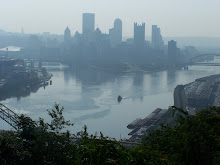Tues., July 29
Barbara Tischler, who handles the curriculum development at Horace Mann and occasionally also teaches history there, followed up the lecture on the Harlem Renaissance with one on the Civil Rights Movement. Her presentation focused more on the music rather than on the history we got yesterday.
She went through the musicians who led up to the civil rights songs: the Fisk Jubilee Singers with their very European performance of “Down by the Riverside”, Johnson’s “Lift Every Voice”, and Paul Robeson’s “Didn’t my Lord Delivery Daniel?” (all mentioned yesterday as part of the Harlem Renaissance). Everyone got excited for the Golden Gate Jubilee Quartet’s performance of “Jezebel”. Ben was nodding to the beat, Ashley was shaking her shoulders, Deane was shaking his head with his eyes closed with Barbara Tischler herself mouthing the words.
Tischler began talking about the Civil Rights Movement with the Albany Movement in the spring of 1962. The Albany Movement was one of the places where music came to play an important role. It was where “We shall overcome”, first introduced by a white guy from California, became a rallying cry for the movement. And it was out of Albany that the Freedom Singers first emerged; the Freedom Singers was the male/female quartet that gained fame touring the college campuses across the country signing songs like “We Shall Overcome” and “This Little Light of Mine”.
She suggested a role-playing activity where students enact a lunch counter sit-in with various students playing waitresses, protesters, restaurant managers, police officers, etc. It sounded like a great activity but a potentially volatile one that would need to be managed and set up properly.
We spent a lot of time talking about Medgar Evers, the state secretary of the NAACP who was killed one night while out for a walk. There is a wealth of literature and song available on this important historical event: Bob Dylan’s “Only a Pawn in Their Game”, “Medgar Evers Lullaby” performed by Judy Collins, Phil Ochs’ “Here’s to the State of Mississippi” (related because Evers’ murder occurred in Mississippi), and even a short story by Eudora Welty entitled “Where is the Voice Coming From?”
She ended with a few songs that, while probably not within the historical period we think of as Civil Rights period, continues the legacy of the civil rights protest movement. Songs like James Browns’ “Say it loud, I’m black and proud” (1968), a song which had Joel shaking his whole torso and which the kids would love; songs like “The Revolution Will not be Televised”, a poem which I’ve always wanted to do in the classroom but which Tischler warned is a difficult one because it is filled with references that the kids don’t know.
One thing was certain as she closed her lecture. I need to get a copy of “Eyes on the Prize”, the recently-released PBS video on the civil rights protest movement.
Barbara Tischler, who handles the curriculum development at Horace Mann and occasionally also teaches history there, followed up the lecture on the Harlem Renaissance with one on the Civil Rights Movement. Her presentation focused more on the music rather than on the history we got yesterday.
She went through the musicians who led up to the civil rights songs: the Fisk Jubilee Singers with their very European performance of “Down by the Riverside”, Johnson’s “Lift Every Voice”, and Paul Robeson’s “Didn’t my Lord Delivery Daniel?” (all mentioned yesterday as part of the Harlem Renaissance). Everyone got excited for the Golden Gate Jubilee Quartet’s performance of “Jezebel”. Ben was nodding to the beat, Ashley was shaking her shoulders, Deane was shaking his head with his eyes closed with Barbara Tischler herself mouthing the words.
Tischler began talking about the Civil Rights Movement with the Albany Movement in the spring of 1962. The Albany Movement was one of the places where music came to play an important role. It was where “We shall overcome”, first introduced by a white guy from California, became a rallying cry for the movement. And it was out of Albany that the Freedom Singers first emerged; the Freedom Singers was the male/female quartet that gained fame touring the college campuses across the country signing songs like “We Shall Overcome” and “This Little Light of Mine”.
She suggested a role-playing activity where students enact a lunch counter sit-in with various students playing waitresses, protesters, restaurant managers, police officers, etc. It sounded like a great activity but a potentially volatile one that would need to be managed and set up properly.
We spent a lot of time talking about Medgar Evers, the state secretary of the NAACP who was killed one night while out for a walk. There is a wealth of literature and song available on this important historical event: Bob Dylan’s “Only a Pawn in Their Game”, “Medgar Evers Lullaby” performed by Judy Collins, Phil Ochs’ “Here’s to the State of Mississippi” (related because Evers’ murder occurred in Mississippi), and even a short story by Eudora Welty entitled “Where is the Voice Coming From?”
She ended with a few songs that, while probably not within the historical period we think of as Civil Rights period, continues the legacy of the civil rights protest movement. Songs like James Browns’ “Say it loud, I’m black and proud” (1968), a song which had Joel shaking his whole torso and which the kids would love; songs like “The Revolution Will not be Televised”, a poem which I’ve always wanted to do in the classroom but which Tischler warned is a difficult one because it is filled with references that the kids don’t know.
One thing was certain as she closed her lecture. I need to get a copy of “Eyes on the Prize”, the recently-released PBS video on the civil rights protest movement.



 Hubbie and friends gone hiking to Kalalau this weekend. Kalalau is an 11-mile hike up and down I don’t know how many valleys to a secluded momma valley and a huge expanse of beach about a ¼ mile deep. The deep green of those sculpted valleys are amazing and a lot of people think the place has some kind of spiritual healing power. An enclave of hippies lives there illegally, living off the food that hikers leave behind. The last time I went to Kalalau I had the rare pleasure of meeting the “librarian” of Kalalau, a rolly polly Santa Claus of a man who I got to see nudie tudes in one of the rest pools. He discretely covered himself with his water bottle and turned the other way hoping we would not stop. There is always drama around Kalalau because you’re only supposed to be in the valley if you have a permit but it takes a year to get a permit so no one has a permit. So every now and again the DLNR (Department of Land and Natural Resources) will send in a helicopter and conduct a raid, instructing all campers without a permit to vacate the valley. This apparently has happened sometimes in the middle of the night, meaning hikers have to begin hiking 11 miles out in the middle of the night. I’m not quite sure exactly how that works.
Hubbie and friends gone hiking to Kalalau this weekend. Kalalau is an 11-mile hike up and down I don’t know how many valleys to a secluded momma valley and a huge expanse of beach about a ¼ mile deep. The deep green of those sculpted valleys are amazing and a lot of people think the place has some kind of spiritual healing power. An enclave of hippies lives there illegally, living off the food that hikers leave behind. The last time I went to Kalalau I had the rare pleasure of meeting the “librarian” of Kalalau, a rolly polly Santa Claus of a man who I got to see nudie tudes in one of the rest pools. He discretely covered himself with his water bottle and turned the other way hoping we would not stop. There is always drama around Kalalau because you’re only supposed to be in the valley if you have a permit but it takes a year to get a permit so no one has a permit. So every now and again the DLNR (Department of Land and Natural Resources) will send in a helicopter and conduct a raid, instructing all campers without a permit to vacate the valley. This apparently has happened sometimes in the middle of the night, meaning hikers have to begin hiking 11 miles out in the middle of the night. I’m not quite sure exactly how that works.


























